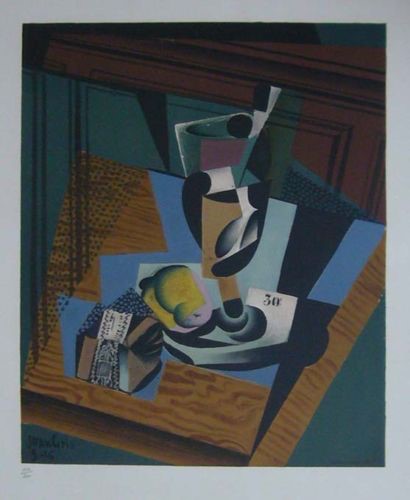Gris
Nature morte au verre et au paquet de Tabac (Still life with Tobacco)
1916
Important work
ARTIST:
Gris, Juan ) b. 1887, Madrid d. 1927 Boulogne-Billancourt, France
Title:
Nature morte au verre et au paquet de Tabac (Still life with Tobacco), after the painting, signed in the plate, “Juan Gris 5-16”, (May 1916) numbered in pencil, 133/200
Technique:
Lithograph in many colours
Paper:
Strong wove 65.6 x 53.5 cm sheet
Condition:
Print is in excellent condition, despite fading and yellowing of the paper at the margins. This does not affect the image itself, colours are still vibrant with a richness of the ink remaining on the surface.
Realisation / Publication:
The yellowing of the paper suggests that this work is one that dates back to when the lithograph was first published. The absence of Gris’ signature in pencil in the margin may be because the work was a HC, or AP (Hors Commerce, Artist’s Proof) and there is no evidence pointing to a later edition. The work did appear in special version as an Exhibition poster. Regardless, this is a beautiful work from a great master painter of the first quarter of the 20th Century.
Reference / Literature:
Cooper, 2013 (for the painting that inspired the lithograph)
Provenance:
Private Dealer, Japan
Asking:
Contact for price
Had he lived for 20 more years (he died in 1927 at aged 40!) Gris may have been the greatest artist of the Twentieth century, a moniker reserved for his contemporary and a man who outlived him by 46 years, Pablo Picasso. So when they are available, works by Juan Gris rarely last on the art market. Why? A subliminal draughtsman, a consummate painter and astute observer of nature, Gris remained committed to Cubism as a form of artist of expression. His subject matter, while often masculine and subdued in terms of the palette he chose to use, Gris’ representation of reality distorted what the eye could see and understood to be a reality. Under Gris’ watchful eye, (science something that guided Gris), the artist rendered all before him in mathematical and spatial terms- that is, a form that was curvilinear in nature became for Gris, a fine edge separating two forms. This is a visual reality that defined the works that are organic by nature. The example on offer here takes an aerial perspective, and in doing so twists and contorts the subject matter. The palette is darker in tone to the original painting, however, this only serves to give the work a richer ambience. Enough said.
NOTE: The work on offer here is one of the late Masters still life subjects that has been skilfully adapted in design by Master printmaker, Henri Deschamps. This name is imprinted lower right of the paper.
Email [email protected] to purchase.
